With contemporary vehicles, as it is with every facet of modern life, technology makes changes and advances rapidly. Constantly evolving technology will continue to shape and change the way we understand and service vehicles now and into the future. Safety systems, however, are still the primary focus, and it is critical to understand how to properly service these sophisticated systems, with brakes being the single most important safety feature of a vehicle. And Audi, often ahead of the curve, is a leader here.
In most vehicles the emergency brake system has not changed much since the days of the first cars. It is typically a simple pawl and ratchet design attached to cables that run to the parking shoes at the rear wheels. Even now, more than a hundred years later, most vehicles still rely on a mechanical lever to control the rear brakes, or parking shoes.
This is beginning to change as technology advances and electronics control more vehicle systems. Braking systems already use electronic controls, so it is logical for the parking brake system to follow suit. Many high-end manufacturers have begun integrating electronic parking brake systems into their cars and, eventually, as the technology becomes less expensive, electronic parking brakes may become standard on every vehicle on the road.
Audi, always striving to stay ahead of the competition with innovations, has taken advantage of the electro-mechanical parking brake (EPB) system on many of their vehicles. This system offers multiple advantages over a basic mechanical brake design.
- Functionality and safety. By communicating over controller area networks (CAN), the electronic parking brake system carries out multiple jobs. Primarily, when parking the vehicle, it is employed by simply pressing the button on the dash, or center console, to lock the rear wheels and prevent the vehicle from moving.
The rear brake actuators are the workhorses of the electro-mechanical parking brake system. Audi has integrated electric motors attached to a multi-stage gear assembly to securely lock the rear wheels. As robust as they are, these electronic actuators do fail from time to time. Most often, the electric drive motors wear out, position sensors fail, or they become damaged by water.
If an actuator fails, it may prevent you from removing the brake caliper during replacement. In these cases, the actuator must be removed from the brake caliper. Once removed, manually turning the exposed drive gear on the caliper will allow the caliper piston to be fully compressed. This is only used in cases where the caliper, or actuator, is damaged, since damage also may occur during manual removal.
In most cases Audi does not sell the actuator separately, and an entire caliper assembly must be purchased. However, the actuator itself is removable and can be replaced. Aftermarket options exist, and often are produced by the same manufacturers that made the OE parts.
The EPB system relies on relatively few sensors and modules for operation. The brain of the EPB is the control module, which resides in the center console area. This communicates all functions for the parking brake system. It also works in conjunction with the antilock braking system (ABS) control unit via CAN bus communication. The control unit houses multiple sensors: lateral acceleration, longitudinal, and a yaw rate sensor. These sensors are used for both stability control and ABS systems as well as parking brake EPB functions.
Another feature of Audi’s electronic parking brake is the hill hold function. This is available on both automatic and manual transmission vehicles. This system integrates a clutch position switch for manual transmission cars. The clutch position switch is extremely important for multiple vehicle systems: vehicle interlock/starting; cruise control; and by sending a pulse width modulated PWM signal to the EPB, the position of the clutch pedal is known. This allows the control unit to determine the proper release point of the rear brakes to ease in hill starting. Acceleration sensors built into the parking brake control unit assist the system in making the determination. This system also connects to the ABS control unit for added stability and safety.
- Cleaner interior layout. One of the first things people notice when getting into an Audi is how luxurious the interior of the vehicle is. By removing the emergency brake handle and replacing it with a button, this allows Audi to create a more sophisticated interior design and layout. This is particularly helpful when many of the accessories, such as the MMI controls, climate control, etc., reside on the center console.
Service
Brake pad wear is unavoidable and can be accelerated, particularly with heavier, more powerful cars. Although front brakes tend to wear out quicker, as they have more weight over them, the rear brakes should not be ignored. Typical brake pad life ranges from 40–60K miles. This varies, of course, depending on driving characteristics and geographical location. Often, vehicles that are parked outside for long periods suffer corrosion and rust buildup. This can result in a warped brake rotor, or in a worst case scenario, a delaminated brake pad or seized caliper. Proper inspection techniques are critical.
Brakes should be inspected at every service without fail. During brake inspection, it is critical to observe both the outboard and inboard pads on both sides of the vehicle, front and back. Often, the inner pad wears more quickly, and an outer brake pad that looks OK at 5mm thickness may have a 2–3mm inboard pad thickness. Often, rear brakes do not have wear sensors, so inspection is necessary here to avoid metal on metal brakes.
Inner brake pad thickness may be difficult to see without using an inspection mirror. In certain cases, with limited visibility through the wheel, removal may be necessary to accurately assess pad thickness. Taking a few additional moments to inspect further will ensure a safe, happy customer and a thorough technician selling a brake job.
European vehicles, including Audi, tend to have a softer metal for brake rotors. The softer metal helps to provide a “stickier†material for the brake pads to adhere to, resulting in a shorter stopping distance and better brake feel. The downside of this is that the rotors wear more quickly.
When rotors wear, a lip is created on the outer, and sometimes inner, edge where the brake pad rides. This lip can cause uneven pad wear, and even noise and vibration. It’s important to measure thickness and know discard limits, and to visually inspect the rotor surfaces. Audi does not recommend machining brake rotors during service. By matching new brake pads with new rotors, the best possible brake performance can be ensured.
Always use original equipment manufacturer (OE) grade pads and rotors. Less expensive off-brand pads and rotors are often made from cheap materials and do not stand the test of time. Inexpensive rotors are usually made from much harder materials and will be noisy and offer poor stopping performance. Audi vehicles are made to be driven hard, and thus require better parts. Don’t be cheap! Nobody likes a comeback.
Critical Tools
Once you have determined that a vehicle needs rear brake replacement, a few critical tools will be needed. Most importantly, proper communications/scanning equipment is required. Audi’s dealer-level VAS software or Vag-com are recommended for reliable scanning. Without properly actuating the rear calipers during the renewal process, damage can occur to the brake caliper. Trying to compress the rear calipers without using scan equipment will absolutely result in damage as well.
A battery charger is also required for the brake renewal process. Because you must remain connected to the vehicle while doing the repair process, battery voltage must be regulated. The EPB system measures the clamping force required to lock the wheels and requires a constant voltage supply to maintain proper operation. The electro-mechanical parking brake module, or EPB, is sensitive to voltage fluctuations and causes problems if battery voltage drops during the process.
Module failure is known to occur if low voltage is present during the process. Conversely, overcharging the battery during EPB service can damage many systems. If your charger has a programming setting, this is ideal. A constant 12.8–14.2 battery voltage is perfect for scanning, programming, etc.
It is not recommended to place charger leads directly onto the battery terminals on many newer Audi models. A battery management module is used to control power to many vehicle systems. Without proper charger lead placement, modules may not be functional. When placing the charging leads on the vehicle, always use the proper charging lugs. These may be located under the hood, or on some models in the trunk of the vehicle.
Once you are connected to the vehicle with the scanner and battery charger, work can begin on rear brake replacement.
The EPB system must be put in “service mode†to allow the caliper pistons to be pushed in. Trying to push in the pistons manually without activating the system properly will result in caliper damage.
With the scanner open, select “group 53-parking brake module.†Once in the module, select “04-basic settings†menu. Basic settings contain multiple actuations and settings changes depending on the vehicle. If using the VAG-com software, there is a drop-down menu visible.
Selecting “Start lining change mode†spins the drive motors fully back into the caliper housings. The motor actuation is audible as well as current values on the scanner. It’s important to wait up to 30 seconds for this process to fully complete. The current value for left and right calipers should both be at zero or very close to zero. You can now exit the scanner and turn the vehicle key to the off position to continue the brake replacement process.
The caliper piston will not appear to have moved at this point. However it is ready to be pushed in like a normal front brake caliper. The inner spindle drive gear has been compressed; however that may not be obvious. Do not attempt to twist in the rear calipers. They have pistons that appear to be keyed for rotating in. To emphasize, DO NOT twist these calipers. Damage will occur.
If replacing the rear rotors, it’s necessary to remove the caliper carriers. VAG vehicles use larger-size triple square sockets to secure the carriers. These are not a standard socket that many technicians have lying around. Be sure to have some on hand before selling a rear brake job. The most common sizes used on Audi vehicles are 14mm 12pt, and 16mm 12pt.
When replacing the pads, it’s important to clean and lightly lubricate the pad carriers. A high-pressure lubricant on the carriers helps to keep the pads from shifting and vibrating. This ensures a smooth moving and rattle/squeak-free brake job. This step is often overlooked by rushing technicians and can potentially cause a comeback if overlooked.
Now that the pads and rotors have been replaced, the rear parking brake system needs to be actuated again. Press on the brake pedal a few times to seat the brake pistons, and insert the key in the ignition. Connect the scanner selecting group 53. Enter basic settings, and select “End lining change mode†under the pull down basic settings menu.
This actuates the parking brake motors on both calipers so the system can recognize its end stops. Allow the system to run the actuation. This may take up to 30 seconds to complete on Audi vehicles. Once this actuation is complete, you may disconnect the scanner. It is always wise to test the system again by actuating the parking brake button. If everything works properly, you are done!
The EPB system may seem complicated and difficult to work with. But the system is actually quite streamlined. As long as proper procedures are followed during the repair process, brake renewal takes only a little longer to complete.
Audi has strived to make the EPB system safe and trouble free. For the most part, they have succeeded. It is up to the technician to stay up to date on these systems to properly and safely service them.
Download PDF

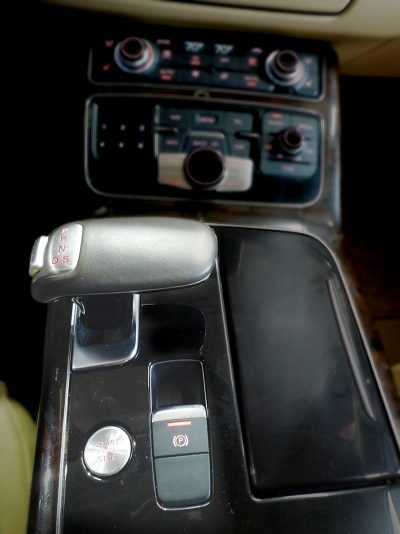

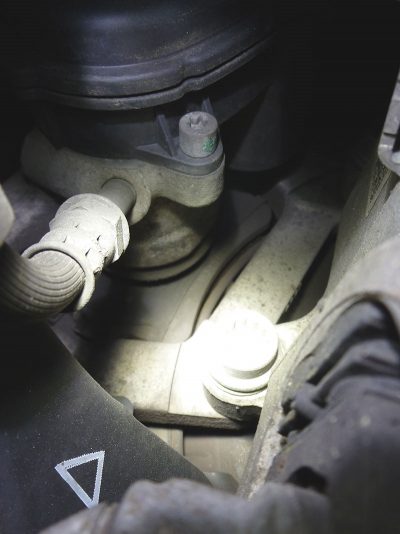

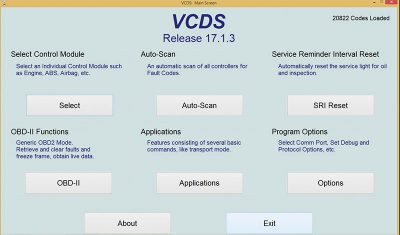
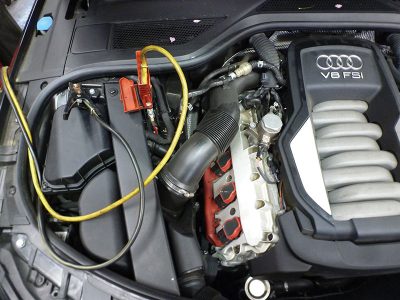
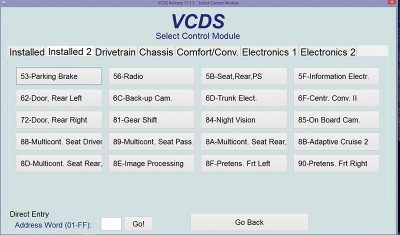
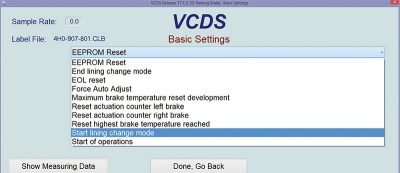
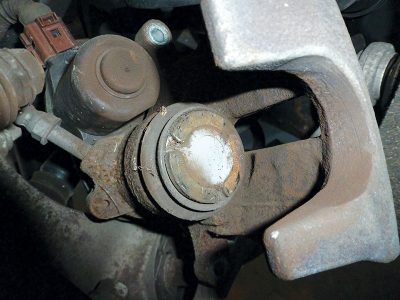
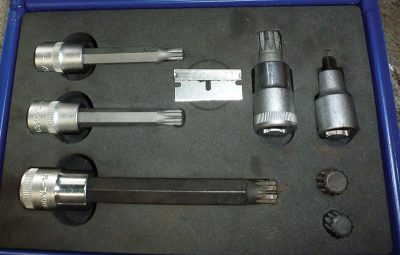




0 Comments